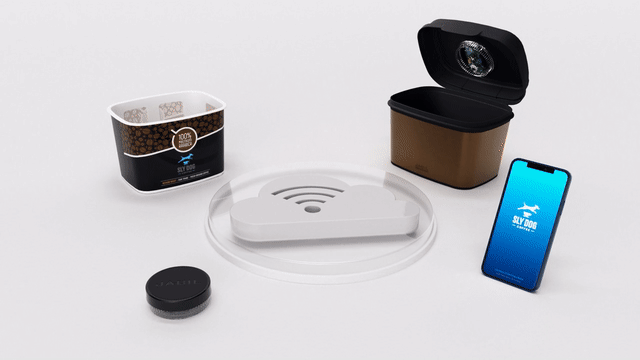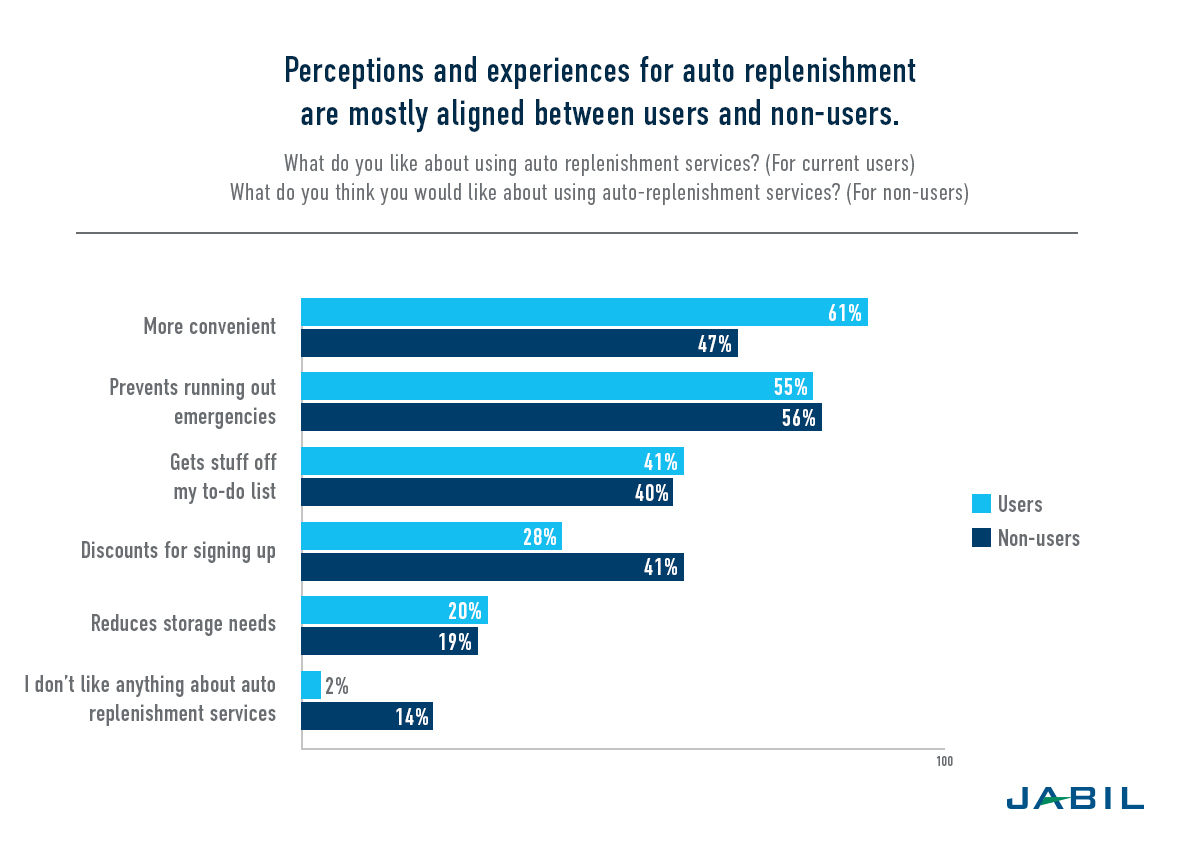Auto Replenishment: Connected Packaging that Delivers.

While most consumers may love going to the store to select a new pair of shoes, that perfect purse or the ideal outfit, not as many enjoy the chore of going to the store and lugging home heavy bottles of detergent, bags of diapers or coffee refills. That's why auto replenishment is the solution that makes sense right out of the gate.
What is Auto Replenishment?
Auto replenishment is a system leveraging connected packaging to sense when the inventory level of your favorite household staples drops below a certain point, informs you and offers a simple, one-click option to order a refill of the product. The auto replenishment order is then automatically delivered before you run out of the product in your home.
Beyond the simple benefits of convenience, time savings and (sometimes) cost savings to the consumer, an auto replenishment program offers a whole lot of added value to the brand, starting with new levels of customer loyalty. Creating a simple route to repurchase allows brands to avoid having to compete for consumers' attention in-store each time a product runs low. This builds a level of comfort and habit for the consumer, and in turn stickiness for the brand.
The biggest difference between subscription services and automatic replenishment is that goods you purchase through subscriptions are delivered at set intervals (which you can postpone and have to manually manage). Auto replenishment, on the other hand, notifies you of the needed purchase only when the product has met the inventory threshold you set.
According to Jabil's 2021 survey of more than 1,000 U.S. consumers, nearly seven in 10 consumers now use subscriptions for household staples-registering a year-over-year growth rate of 48%. Moreover, 77% of consumers say they are likely to purchase a subscription service in the future if the right product is available at the right price. Download the full survey report.
As subscription services mature, auto replenishment is the next logical step. Though it's still a novel concept, auto replenishment is a big part of the CPG digital transformation. In fact, more than a quarter of consumers say they currently use auto replenishment services for household staples, a 58% growth in the last year.
How Does the Auto Replenishment Process Work?

How Does Auto Replenishment Work?
There are different ways to make auto replenishment work. Here at Jabil we recommend three building blocks to make it a reality:
- Connected Device: Whether it comes in the form of a small device that gets attached to a refill container or a device and consumable system, these technologies use various sensors (proximity, weight, etc.) to precisely measure the amount of remaining product and leverages a Wi-Fi antenna to communicate that information to the cloud.
- Consumable Package: A mono-material, recyclable package contains the product the consumer receives when they utilize an auto replenish order. These packages are designed to work with the durable device to offer sustainability and weight advantages over traditional packaging.
- Smartphone Application: A smartphone app allows consumers to identify the product they would like to have automatically replenished. They simply choose a brand and define the auto replenishment service thresholds that will work best for their home and family.
Once you have a digital feature or a sensor in a product, you have data. Consumer data is the rocket fuel that thrusts products, business models and industries. Connected packaging delivers data to brands or retailers, and this is where it gets exciting. Armed with insightful user data, a brand can see how the habits of their users vary depending on criteria like demographics, region and time. This valuable user data can be used to predict demand, refine product design, test new features or lines or perhaps drive special marketing promotions or offers. With demand forecast improvement, an automatic replenishment system can also support supply chain efficiencies, better inventory management and exceptional customer service.
Are Consumers Ready for Auto Replenishment?
The short answer: yes.
Here's the long answer. Early trials of an auto replenishment system began with the now-discontinued Amazon Dash button-which offered the service for over 150 products. The concept was simple. The button was designed to be placed around the home in convenient areas so you would never forget to reorder a household staple that was running low. With a simple push of the button, your reorder would be placed.
Since the button, the company has evolved its service to Amazon Dash Replenishment services, which empower consumers to conveniently reorder products through Alexa. The service integrates with a consumer's connected devices to track supply levels through the Alexa app, which triggers notifications when supplies are running low and allows quick reorders. For example, the service can integrate with your connected thermostat to keep track of fan hours to determine filter life, so the consumer never has to keep track of when to change the filter. Jabil is a system integrator for Amazon Dash Replenishment services as well, helping device makers easily integrate with the program.
As I mentioned earlier, 27% of consumers affirm that they use these services for household staples. Most importantly, 79% say they are interested in auto replenishment services-a 25% growth rate since last year. Consumers are getting more comfortable with letting technology track the mundane in their home. Of all the demographics that are interested in these services, certain segments are more likely to show interest in auto replenishment. Those include millennials, high-income households, those with smart speakers and households with infants.
In the survey, we also gathered insights on the experiences of those using auto replenishment to find out what they like about these services and compared them to the perceptions of those who don't currently use auto-replenishment. Perceptions and experiences were aligned for the most part. The biggest differences? Those who use the services are 30% more likely to find them more convenient. Those who don't use auto replenishment are 46% more likely to think about discounts for signing up.

Perceptions and experiences of auto-replenishment service users vs non-users
Finally, we asked consumers to think about the kind of product categories that are the best fit for auto replenishment in their lives. Home care goods (detergents, cleaning products, air filters, etc.), personal care staples (skin care, shampoo, shaving, etc.) and pet care items (food, litter, medication, etc.) were common across most participants. However it is important to note that 60% of pet owners affirmed pet care was the best fit for them and 65% of households with infants found the infant care category (diapers, wipes, formula, etc.) to be the best fit for them.
In your life, what kinds of products are the best fit for auto-replenishment services? Choose all that apply.
The future of packaging is connected—enabling a new landscape where CPGs must think differently to provide an improved, personalized user experience. Only then will we be able to elevate the customer relationship from one that is transactional to one that is meaningful. For the consumer, all the bells and whistles fade into insignificance against two simple benefits. One, never running out of a product you love and/or need. And two, not having to go to the store and pick it up—all giving the consumer back his or her most valuable resource—time!
Jabil's Connected Packaging Solutions
Connected Packaging brings the future into our homes today, allowing consumer packaged goods brands to disrupt the marketplace with game-changing auto-replenishment that transforms the user experience and boosts brand loyalty.
Learn More
.2023-01-11-18-03-34.jpg)